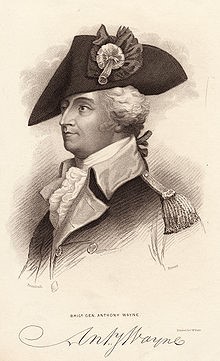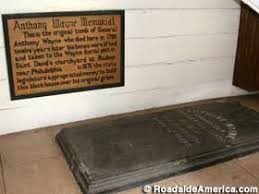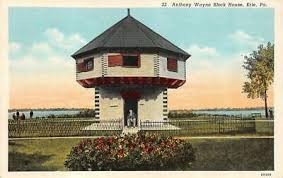I see it almost every day. You have probably seen it yourself, either as a student going through the museum or as an adult touring. That’s right…the Wayne pot. Having seen it or not, you may not believe the story, but it is true. As I retell it now, I must issue a warning though. This story is not in my general theme of happiness and long life, but it is a good one and as far as I know, it is true.

Anthony Wayne was born January 1, 1745 in Chester County Pennsylvania. Raised in a somewhat affluent family, he was educated as a surveyor then studied military tactics. He enlisted in the Continental Army during the Revolutionary War and served valiantly in many campaigns, eventually serving with General Washington. Wayne was not crazy but earned the nickname “Mad” due to his dash and bravery during battle.
On September 20, 1777, while stationed at Paoli near his Chester County home with 1,500 men, his position was betrayed by some Tories to the enemy. Approximately 1/10 of his men were either killed or wounded and a court martial, led by Washington, determined that Wayne was not at fault for the massacre. It could have ended his career if found otherwise.

After the Revolutionary War, President Washington made Wayne a Major General and assigned him to the Northwest frontier to subjugate the Natives. The wars ended with the Battle of Fallen Timbers (near current day Toledo, Ohio), a 1-hour long confrontation that scattered the Native warriors. The Treaty of Greenville in 1795 with the native people opened Western Pennsylvania and Northern Ohio to American settlement.
Major General Wayne suffered for years with gout, and the primitive western living conditions and hostilities made matters worse. In 1796, as he was heading east on Lake Erie by boat to eventually to make his way back home, he asked to stop at Fort Presque Isle in Erie because he was so sick. He was taken to the fort blockhouse and sent word to Dr. J.C. Wallace who was stationed near Pittsburgh to come to Erie for medical assistance. By the time the doctor received the message and made it as far north as Franklin, the news arrived that the general was dead.
Wayne was buried at the foot of the blockhouse flagpole wearing his boots and uniform, with full military honors. At that time, he was the senior ranking officer in the US army.

Thirteen years later, Colonel Isaac Wayne, the general’s son, decided it was time his father’s body was returned home. Wanting to remember his father the way he was in life, Isaac Wayne sought the assistance of Dr. Wallace to prepare the remains for transfer. The grave was dug up and to everyone’s surprise, the body was perfectly petrified except for one foot and a leg. One boot was destroyed and most of his clothing was missing. Dr. Wallace went to work separating the body into “convenient parts”, placed it in a kettle of boiling water, scraped the bones and packed them in a small box. The flesh and tools used in the process were returned to the grave. The bones were buried by Isaac in the St. David’s Episcopal Church cemetery in Radnor, Delaware County Pennsylvania.
Fast forward to 1878 when Erie’s health officer, Dr. Germer wanted to locate the grave of the national hero. He determined where the long-gone blockhouse was and found the grave with some digging in the area. As a memorial to Wayne, the blockhouse was rebuilt in 1880 and the grave suitably marked therein.

General “Mad” Anthony Wayne lives today in the names of many cities, towns, schools, streets, businesses and even beer (Erie Brewing’s “Mad Anthony Ale”). Just to name a few of the cities are: Fort Wayne Indiana, Wayne Michigan and Waynesboro Pennsylvania. Did you know that “Batman” Bruce Wayne is a descendent of Anthony Wayne? That’s what I read on the internet anyways.
The Wayne “pot” is currently not on exhibit but will be again when we are able to open the Wood-Morrison House and new Exhibit buildings to the public. It is one of our most iconic objects and unusual stories about Erie history. Stay healthy and be happy!
